Examining Religion's Impact on the Sunni-Shia Conflict in Yemen
VerifiedAdded on 2023/02/01
|5
|1350
|94
Essay
AI Summary
This essay delves into the role of religion in the Yemen civil war, specifically focusing on the conflict between Sunni and Shia Muslims. It explores the historical roots of the sectarian divide, tracing the split back to the death of Prophet Muhammad and the subsequent leadership disputes. The essay highlights how political ambitions, regional rivalries (particularly between Saudi Arabia and Iran), and territorial disputes have exacerbated the religious tensions, turning them into a major driver of the conflict. It examines the involvement of various actors, including the Houthi rebels, the United Nations, and terrorist groups like Al-Qaeda and ISIS, and how the conflict has led to a humanitarian crisis. The essay concludes by emphasizing how religion has been used as a tool for political gain and regional dominance, ultimately hindering peace and violating humanitarian principles. It also references the importance of the global media's portrayal of the war and how it has violated humanitarian aid and human rights.
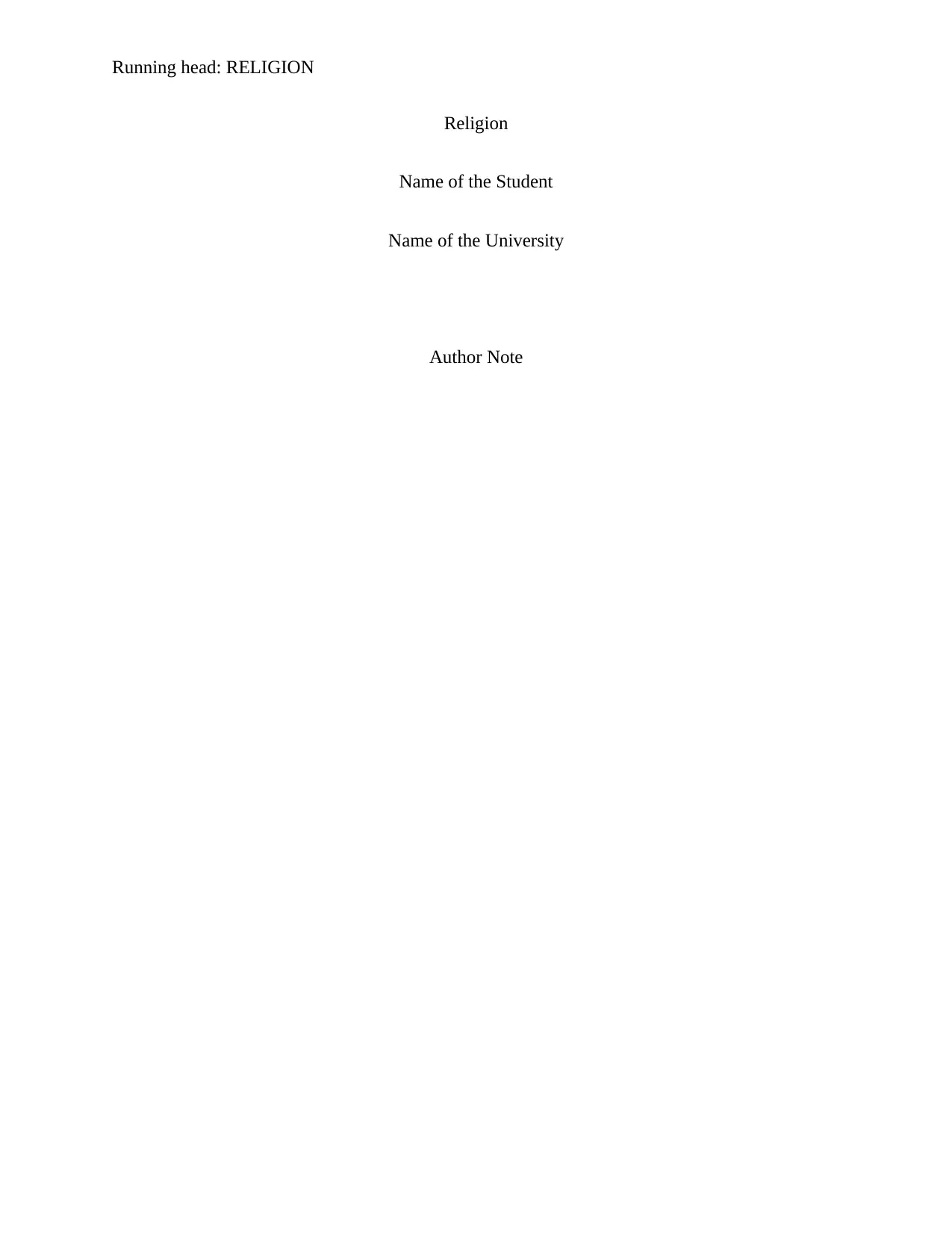
Running head: RELIGION
Religion
Name of the Student
Name of the University
Author Note
Religion
Name of the Student
Name of the University
Author Note
Paraphrase This Document
Need a fresh take? Get an instant paraphrase of this document with our AI Paraphraser
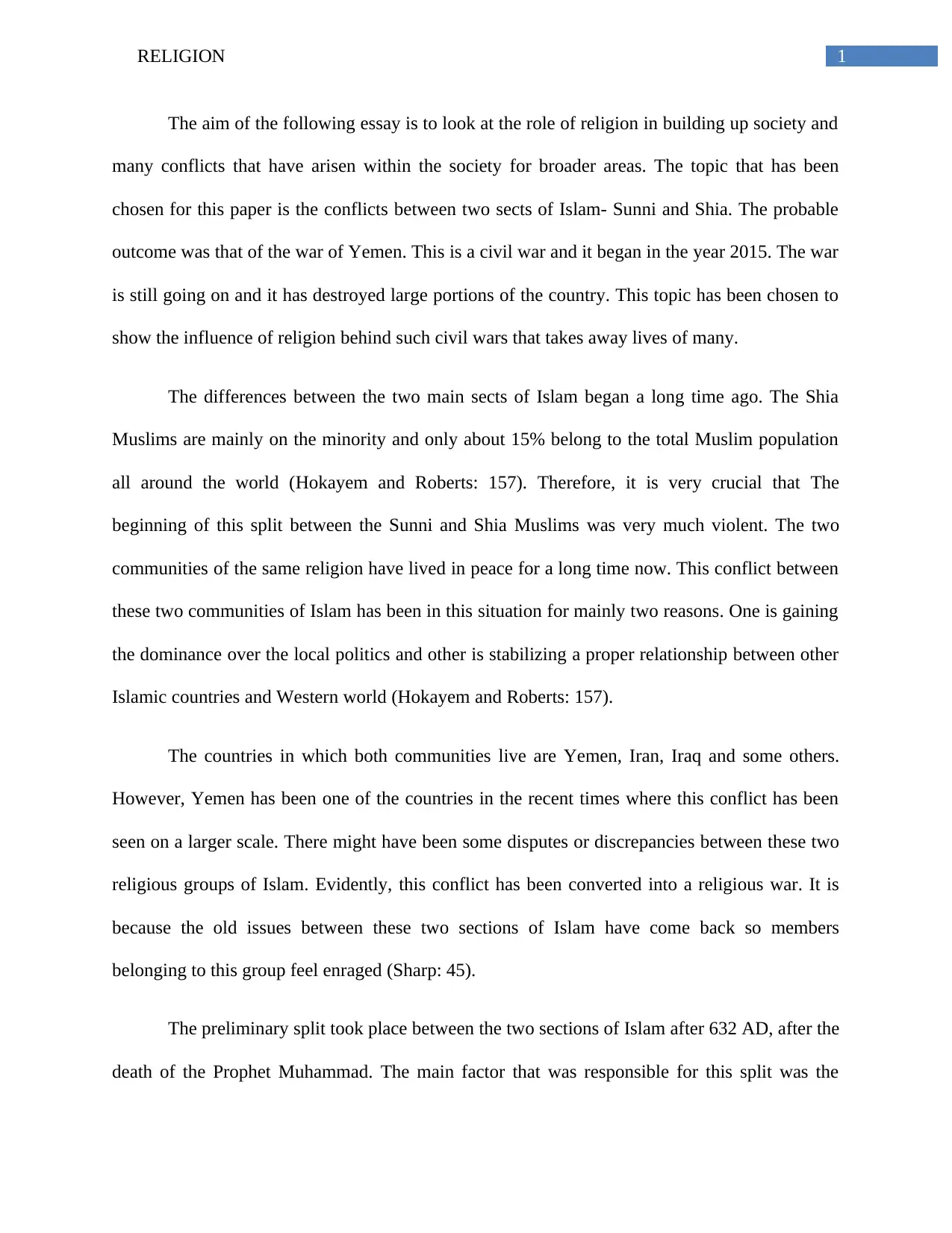
1RELIGION
The aim of the following essay is to look at the role of religion in building up society and
many conflicts that have arisen within the society for broader areas. The topic that has been
chosen for this paper is the conflicts between two sects of Islam- Sunni and Shia. The probable
outcome was that of the war of Yemen. This is a civil war and it began in the year 2015. The war
is still going on and it has destroyed large portions of the country. This topic has been chosen to
show the influence of religion behind such civil wars that takes away lives of many.
The differences between the two main sects of Islam began a long time ago. The Shia
Muslims are mainly on the minority and only about 15% belong to the total Muslim population
all around the world (Hokayem and Roberts: 157). Therefore, it is very crucial that The
beginning of this split between the Sunni and Shia Muslims was very much violent. The two
communities of the same religion have lived in peace for a long time now. This conflict between
these two communities of Islam has been in this situation for mainly two reasons. One is gaining
the dominance over the local politics and other is stabilizing a proper relationship between other
Islamic countries and Western world (Hokayem and Roberts: 157).
The countries in which both communities live are Yemen, Iran, Iraq and some others.
However, Yemen has been one of the countries in the recent times where this conflict has been
seen on a larger scale. There might have been some disputes or discrepancies between these two
religious groups of Islam. Evidently, this conflict has been converted into a religious war. It is
because the old issues between these two sections of Islam have come back so members
belonging to this group feel enraged (Sharp: 45).
The preliminary split took place between the two sections of Islam after 632 AD, after the
death of the Prophet Muhammad. The main factor that was responsible for this split was the
The aim of the following essay is to look at the role of religion in building up society and
many conflicts that have arisen within the society for broader areas. The topic that has been
chosen for this paper is the conflicts between two sects of Islam- Sunni and Shia. The probable
outcome was that of the war of Yemen. This is a civil war and it began in the year 2015. The war
is still going on and it has destroyed large portions of the country. This topic has been chosen to
show the influence of religion behind such civil wars that takes away lives of many.
The differences between the two main sects of Islam began a long time ago. The Shia
Muslims are mainly on the minority and only about 15% belong to the total Muslim population
all around the world (Hokayem and Roberts: 157). Therefore, it is very crucial that The
beginning of this split between the Sunni and Shia Muslims was very much violent. The two
communities of the same religion have lived in peace for a long time now. This conflict between
these two communities of Islam has been in this situation for mainly two reasons. One is gaining
the dominance over the local politics and other is stabilizing a proper relationship between other
Islamic countries and Western world (Hokayem and Roberts: 157).
The countries in which both communities live are Yemen, Iran, Iraq and some others.
However, Yemen has been one of the countries in the recent times where this conflict has been
seen on a larger scale. There might have been some disputes or discrepancies between these two
religious groups of Islam. Evidently, this conflict has been converted into a religious war. It is
because the old issues between these two sections of Islam have come back so members
belonging to this group feel enraged (Sharp: 45).
The preliminary split took place between the two sections of Islam after 632 AD, after the
death of the Prophet Muhammad. The main factor that was responsible for this split was the
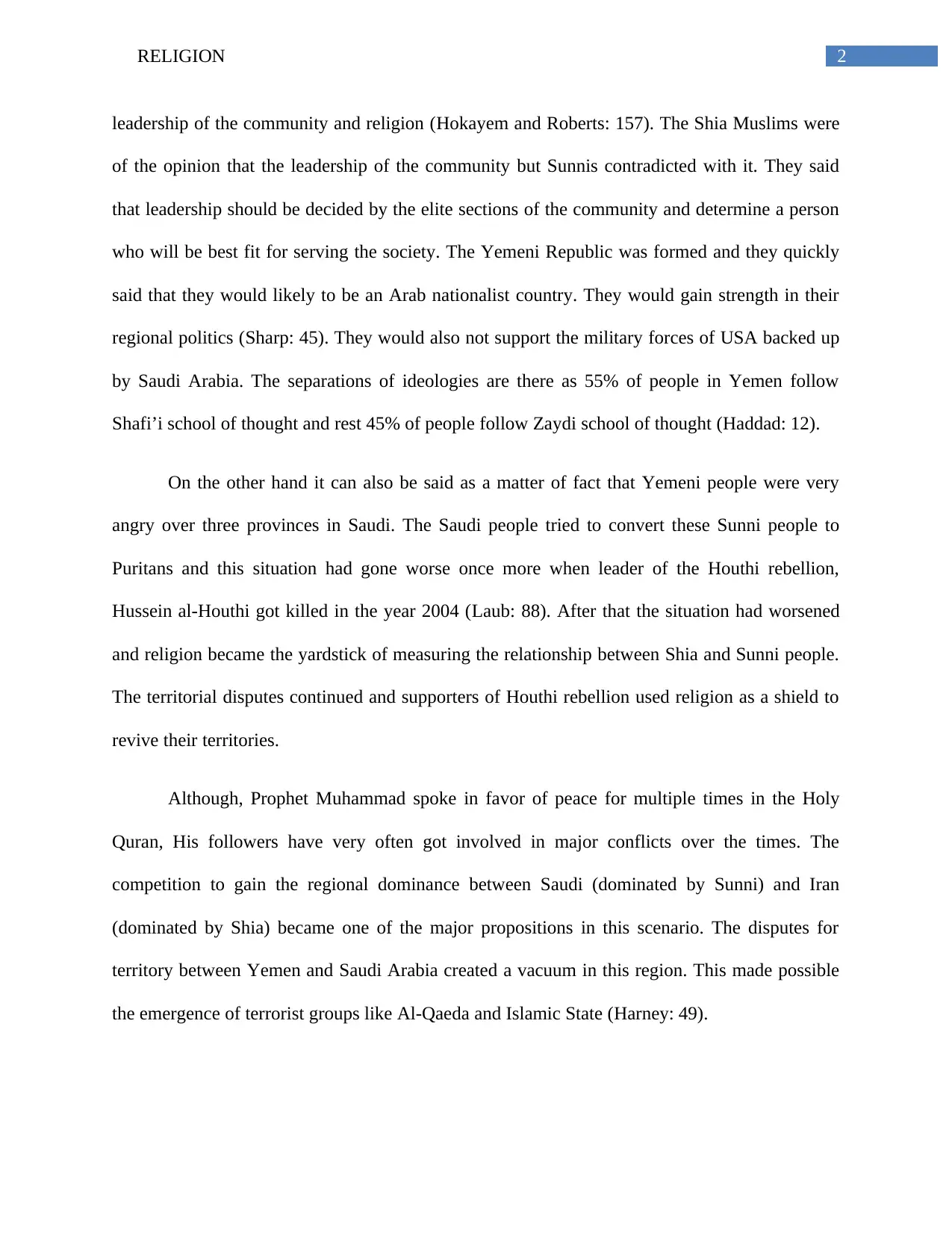
2RELIGION
leadership of the community and religion (Hokayem and Roberts: 157). The Shia Muslims were
of the opinion that the leadership of the community but Sunnis contradicted with it. They said
that leadership should be decided by the elite sections of the community and determine a person
who will be best fit for serving the society. The Yemeni Republic was formed and they quickly
said that they would likely to be an Arab nationalist country. They would gain strength in their
regional politics (Sharp: 45). They would also not support the military forces of USA backed up
by Saudi Arabia. The separations of ideologies are there as 55% of people in Yemen follow
Shafi’i school of thought and rest 45% of people follow Zaydi school of thought (Haddad: 12).
On the other hand it can also be said as a matter of fact that Yemeni people were very
angry over three provinces in Saudi. The Saudi people tried to convert these Sunni people to
Puritans and this situation had gone worse once more when leader of the Houthi rebellion,
Hussein al-Houthi got killed in the year 2004 (Laub: 88). After that the situation had worsened
and religion became the yardstick of measuring the relationship between Shia and Sunni people.
The territorial disputes continued and supporters of Houthi rebellion used religion as a shield to
revive their territories.
Although, Prophet Muhammad spoke in favor of peace for multiple times in the Holy
Quran, His followers have very often got involved in major conflicts over the times. The
competition to gain the regional dominance between Saudi (dominated by Sunni) and Iran
(dominated by Shia) became one of the major propositions in this scenario. The disputes for
territory between Yemen and Saudi Arabia created a vacuum in this region. This made possible
the emergence of terrorist groups like Al-Qaeda and Islamic State (Harney: 49).
leadership of the community and religion (Hokayem and Roberts: 157). The Shia Muslims were
of the opinion that the leadership of the community but Sunnis contradicted with it. They said
that leadership should be decided by the elite sections of the community and determine a person
who will be best fit for serving the society. The Yemeni Republic was formed and they quickly
said that they would likely to be an Arab nationalist country. They would gain strength in their
regional politics (Sharp: 45). They would also not support the military forces of USA backed up
by Saudi Arabia. The separations of ideologies are there as 55% of people in Yemen follow
Shafi’i school of thought and rest 45% of people follow Zaydi school of thought (Haddad: 12).
On the other hand it can also be said as a matter of fact that Yemeni people were very
angry over three provinces in Saudi. The Saudi people tried to convert these Sunni people to
Puritans and this situation had gone worse once more when leader of the Houthi rebellion,
Hussein al-Houthi got killed in the year 2004 (Laub: 88). After that the situation had worsened
and religion became the yardstick of measuring the relationship between Shia and Sunni people.
The territorial disputes continued and supporters of Houthi rebellion used religion as a shield to
revive their territories.
Although, Prophet Muhammad spoke in favor of peace for multiple times in the Holy
Quran, His followers have very often got involved in major conflicts over the times. The
competition to gain the regional dominance between Saudi (dominated by Sunni) and Iran
(dominated by Shia) became one of the major propositions in this scenario. The disputes for
territory between Yemen and Saudi Arabia created a vacuum in this region. This made possible
the emergence of terrorist groups like Al-Qaeda and Islamic State (Harney: 49).
⊘ This is a preview!⊘
Do you want full access?
Subscribe today to unlock all pages.

Trusted by 1+ million students worldwide
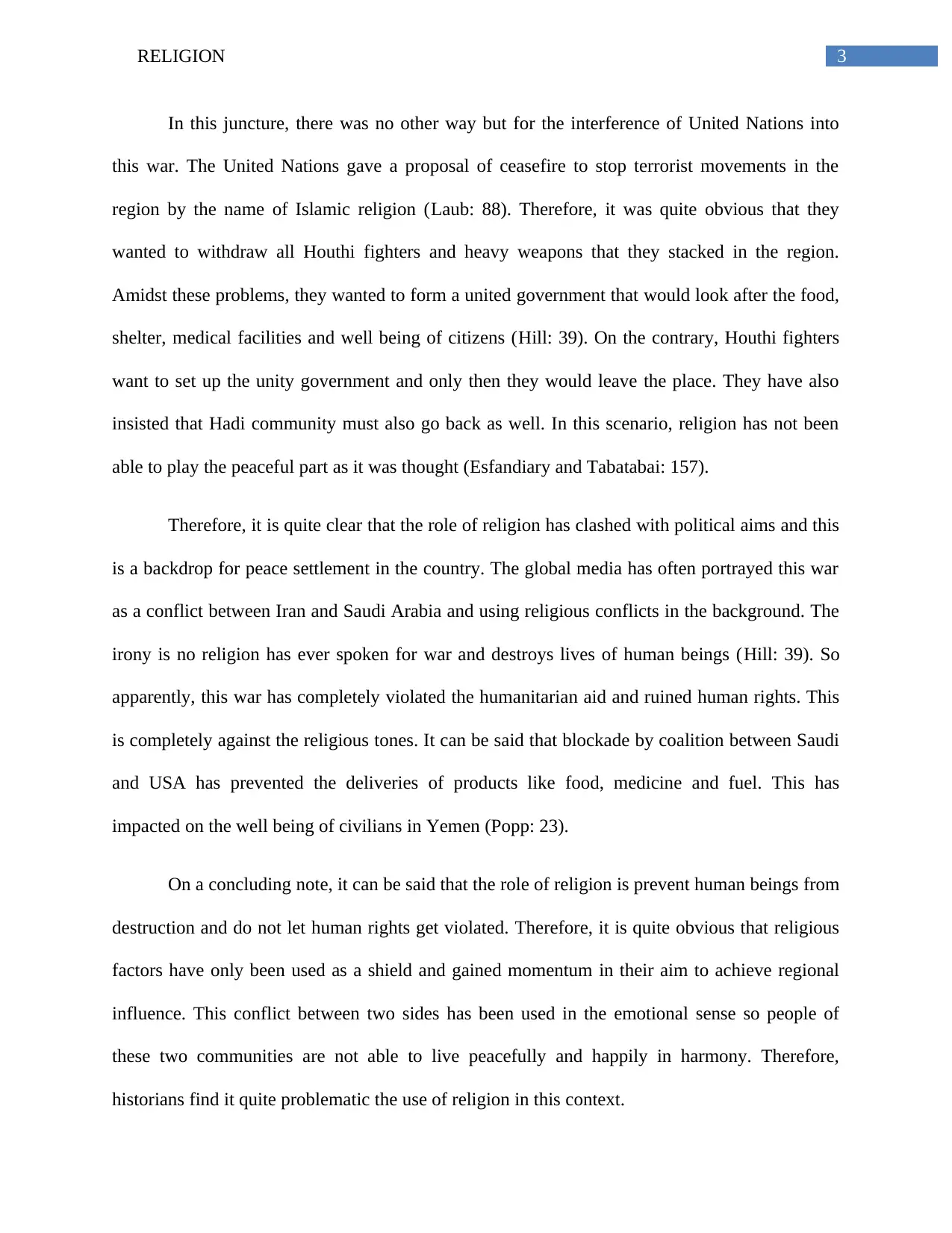
3RELIGION
In this juncture, there was no other way but for the interference of United Nations into
this war. The United Nations gave a proposal of ceasefire to stop terrorist movements in the
region by the name of Islamic religion (Laub: 88). Therefore, it was quite obvious that they
wanted to withdraw all Houthi fighters and heavy weapons that they stacked in the region.
Amidst these problems, they wanted to form a united government that would look after the food,
shelter, medical facilities and well being of citizens (Hill: 39). On the contrary, Houthi fighters
want to set up the unity government and only then they would leave the place. They have also
insisted that Hadi community must also go back as well. In this scenario, religion has not been
able to play the peaceful part as it was thought (Esfandiary and Tabatabai: 157).
Therefore, it is quite clear that the role of religion has clashed with political aims and this
is a backdrop for peace settlement in the country. The global media has often portrayed this war
as a conflict between Iran and Saudi Arabia and using religious conflicts in the background. The
irony is no religion has ever spoken for war and destroys lives of human beings (Hill: 39). So
apparently, this war has completely violated the humanitarian aid and ruined human rights. This
is completely against the religious tones. It can be said that blockade by coalition between Saudi
and USA has prevented the deliveries of products like food, medicine and fuel. This has
impacted on the well being of civilians in Yemen (Popp: 23).
On a concluding note, it can be said that the role of religion is prevent human beings from
destruction and do not let human rights get violated. Therefore, it is quite obvious that religious
factors have only been used as a shield and gained momentum in their aim to achieve regional
influence. This conflict between two sides has been used in the emotional sense so people of
these two communities are not able to live peacefully and happily in harmony. Therefore,
historians find it quite problematic the use of religion in this context.
In this juncture, there was no other way but for the interference of United Nations into
this war. The United Nations gave a proposal of ceasefire to stop terrorist movements in the
region by the name of Islamic religion (Laub: 88). Therefore, it was quite obvious that they
wanted to withdraw all Houthi fighters and heavy weapons that they stacked in the region.
Amidst these problems, they wanted to form a united government that would look after the food,
shelter, medical facilities and well being of citizens (Hill: 39). On the contrary, Houthi fighters
want to set up the unity government and only then they would leave the place. They have also
insisted that Hadi community must also go back as well. In this scenario, religion has not been
able to play the peaceful part as it was thought (Esfandiary and Tabatabai: 157).
Therefore, it is quite clear that the role of religion has clashed with political aims and this
is a backdrop for peace settlement in the country. The global media has often portrayed this war
as a conflict between Iran and Saudi Arabia and using religious conflicts in the background. The
irony is no religion has ever spoken for war and destroys lives of human beings (Hill: 39). So
apparently, this war has completely violated the humanitarian aid and ruined human rights. This
is completely against the religious tones. It can be said that blockade by coalition between Saudi
and USA has prevented the deliveries of products like food, medicine and fuel. This has
impacted on the well being of civilians in Yemen (Popp: 23).
On a concluding note, it can be said that the role of religion is prevent human beings from
destruction and do not let human rights get violated. Therefore, it is quite obvious that religious
factors have only been used as a shield and gained momentum in their aim to achieve regional
influence. This conflict between two sides has been used in the emotional sense so people of
these two communities are not able to live peacefully and happily in harmony. Therefore,
historians find it quite problematic the use of religion in this context.
Paraphrase This Document
Need a fresh take? Get an instant paraphrase of this document with our AI Paraphraser
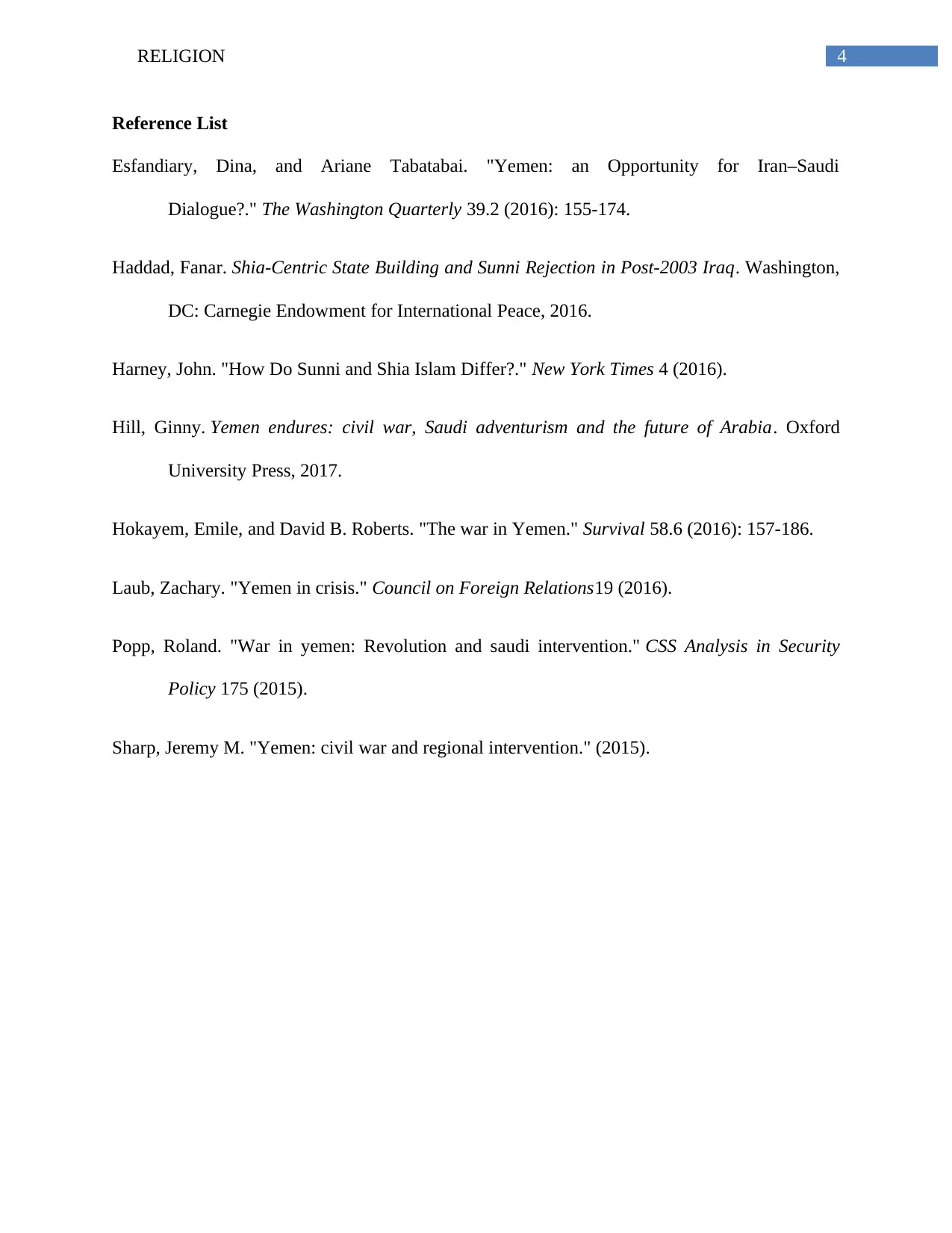
4RELIGION
Reference List
Esfandiary, Dina, and Ariane Tabatabai. "Yemen: an Opportunity for Iran–Saudi
Dialogue?." The Washington Quarterly 39.2 (2016): 155-174.
Haddad, Fanar. Shia-Centric State Building and Sunni Rejection in Post-2003 Iraq. Washington,
DC: Carnegie Endowment for International Peace, 2016.
Harney, John. "How Do Sunni and Shia Islam Differ?." New York Times 4 (2016).
Hill, Ginny. Yemen endures: civil war, Saudi adventurism and the future of Arabia. Oxford
University Press, 2017.
Hokayem, Emile, and David B. Roberts. "The war in Yemen." Survival 58.6 (2016): 157-186.
Laub, Zachary. "Yemen in crisis." Council on Foreign Relations19 (2016).
Popp, Roland. "War in yemen: Revolution and saudi intervention." CSS Analysis in Security
Policy 175 (2015).
Sharp, Jeremy M. "Yemen: civil war and regional intervention." (2015).
Reference List
Esfandiary, Dina, and Ariane Tabatabai. "Yemen: an Opportunity for Iran–Saudi
Dialogue?." The Washington Quarterly 39.2 (2016): 155-174.
Haddad, Fanar. Shia-Centric State Building and Sunni Rejection in Post-2003 Iraq. Washington,
DC: Carnegie Endowment for International Peace, 2016.
Harney, John. "How Do Sunni and Shia Islam Differ?." New York Times 4 (2016).
Hill, Ginny. Yemen endures: civil war, Saudi adventurism and the future of Arabia. Oxford
University Press, 2017.
Hokayem, Emile, and David B. Roberts. "The war in Yemen." Survival 58.6 (2016): 157-186.
Laub, Zachary. "Yemen in crisis." Council on Foreign Relations19 (2016).
Popp, Roland. "War in yemen: Revolution and saudi intervention." CSS Analysis in Security
Policy 175 (2015).
Sharp, Jeremy M. "Yemen: civil war and regional intervention." (2015).
1 out of 5
Related Documents
Your All-in-One AI-Powered Toolkit for Academic Success.
+13062052269
info@desklib.com
Available 24*7 on WhatsApp / Email
![[object Object]](/_next/static/media/star-bottom.7253800d.svg)
Unlock your academic potential
Copyright © 2020–2025 A2Z Services. All Rights Reserved. Developed and managed by ZUCOL.





